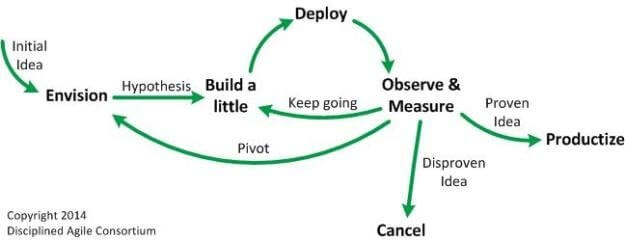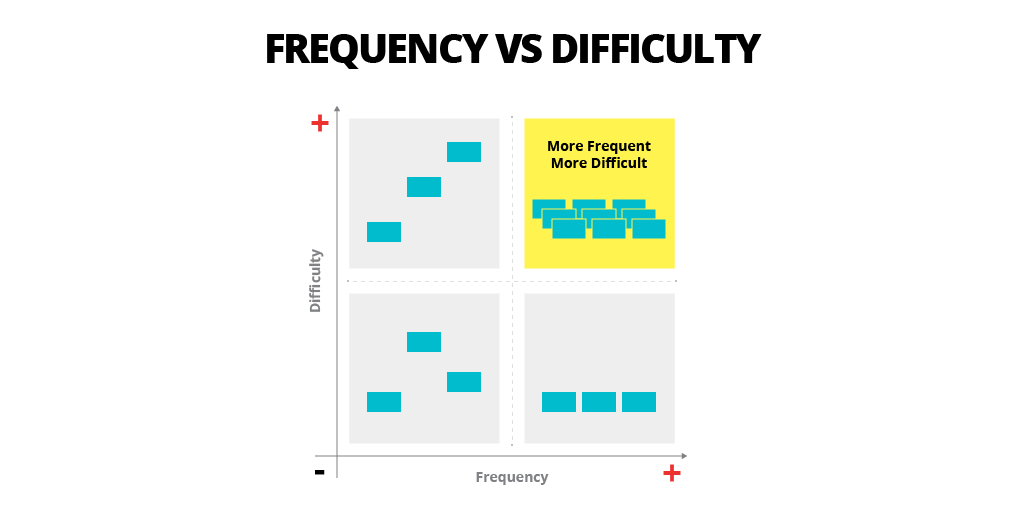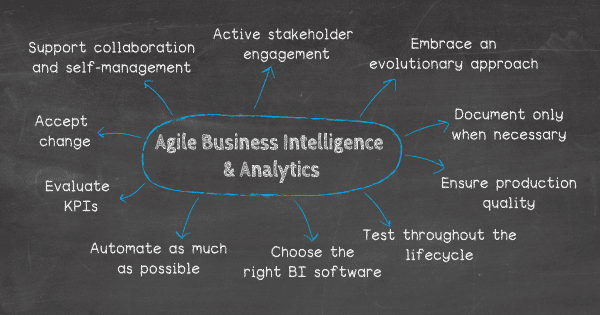Accomplish Agile Business Intelligence & Analytics For Your Business
When it comes to implementing and managing a successful BI strategy we have always proclaimed: start small, use the right BI tools, and involve your team. We know that the best approach is an iterative and flexible approach, no matter the size of your company, industry or simply a department. When encouraging these BI best practices what we are really doing is advocating for agile business intelligence and analytics.
That said, in this article, we will go through both agile analytics and BI starting from basic definitions, and continuing with methodologies, tips, and tricks to help you implement these processes and give you a clear overview of how to use them. In our opinion, both terms, agile BI and agile analytics, are interchangeable and mean the same. Therefore, we will walk you through this beginner’s guide on agile business intelligence and analytics to help you understand how they work and the methodology behind them. Without further ado, let's begin.
What Is Agile Analytics And BI?
Agile analytics (or agile business intelligence) is a term used to describe software development methodologies used in BI and analytical processes in order to establish flexibility, improve functionality, and adapt to new business demands in BI and analytical projects.
It's necessary to say that these processes are recurrent and require continuous evolution of reports, online data visualization, dashboards, and new functionalities to adapt current processes and develop new ones. In essence, these processes are divided into smaller sections but have the same goal: to help companies, small businesses, and large enterprises alike, adapt quickly to business goals and ever-changing market circumstances. To build your company even more, we suggest you read our article on the subject of enterprise software applications.
It's often the case that businesses need to develop an agile BI methodology in order to successfully meet companies' requirements of strategic developments as well as operational ones. No matter if you need to develop a comprehensive online data analysis process or reduce costs of operations, agile BI development will certainly be high on your list of options to get the most out of your projects.
The term "agile" was originally conceived in 2011 as a software development methodology. 17 software developers met to discuss lightweight development methods and subsequently produced the following manifesto:
Manifesto for Agile Software Development:
Individuals and interactions over processes and tools Working software over comprehensive documentation Customer collaboration over contract negotiation Responding to change over following a plan
That is, while there is value in the items on the right, we value the items on the left more.
And like that, agile was born. As a software development methodology, agile is a time-boxed, iterative approach to software delivery that builds software incrementally, instead of trying to deliver the entire product at the end. Due to the success of its methodology, agile has successfully migrated beyond its initial scope and is now being used successfully as a project management methodology across numerous industries. With an emphasis on adaptivity over rigidity and collaboration over hierarchy, it’s easy to see why agile is becoming the chosen methodology for so many.

Source: www.pmi.org
To look into these processes in more detail, we will now explain the agile BI methodology as well as for analytics and provide steps for agile BI development.
Agile Business Intelligence & Analytics Methodology
Business intelligence is moving away from the traditional engineering model: analysis, design, construction, testing, and implementation. In the traditional model communication between developers and business users is not a priority. Also, developers are more focused on data and technology than answering more important questions:
- "What business questions do we want to answer with the available data in order to support the decision-making process?"
- “What do our users actually need?”
Through agile adoption, organizations are seeing a quicker return on their BI investments and are able to quickly adapt to changing business needs. To fully utilize agile business analytics, we will go through a basic agile framework in regards to BI implementation and management. You may find different versions of this to adopt but the underlying methodology is the same. Let's start with the concept.
1. Concept
This is the stage where you start to develop a loose BI vision. The agile BI implementation methodology starts with light documentation: you don’t have to heavily map this out. A whiteboard meeting will suffice, where you can explain the initial architecture, consider the practical aspects of delivering the project, and identify the prioritization between them. Details will be taken into consideration later, therefore, focus on the concept and develop from there.
2. Inception
The inception stage is the critical initiation stage. This is when you first implement active stakeholder participation. You also:
- Train project stakeholders in agile fundamentals
- Determine BI funding and support
- Identify key business requirements and needs. This includes understanding the business questions to be answered through the BI system
- Discover the available data sources
- Understand the expected information delivery avenues: reports, dashboards, ad hoc reporting, etc.
- Then prioritize key business requirements and needs with time and budget constraints in mind. An effective prioritization technique is to write user stories for each business question identified. Then use a frequency vs. difficulty quadrant to prioritize them. The top right quadrant includes the business questions that are most frequently asked and are the most difficult to answer with existing data. These stories can be considered as a high priority. The bottom right corner of least difficult and most requested might be some good low hanging fruit as well!

Source: www.thoughtworks.com
- During this stage, you are also researching and vetting which online business intelligence software to use. You need to determine if you are going with an on-premise or cloud-hosted strategy. Then, you need to choose AND set-up the right BI solution for your organization!
3. Construction Iterations
During construction, you are delivering a working system that meets the evolving needs of stakeholders. You will continually cycle through this stage to stage 4 at set increments, usually 1-3 weeks long. Eventually, after stages 3 and 4 are done you move to stage 5 (production). But before production, you need to develop documentation, test driven design (TDD), and implement these important steps:
- Actively involve key stakeholders once again
- Collaboratively develop reports
- Utilize the "just in time" (JIT) modeling: identify an issue that needs resolving, grab a few co-workers and explore the issue, and then everyone continues as before. This is also known as model storming, one of the practices in agile analytics development
- Test BI in a small group and deploy the software internally
4. Transition (aka Release or End Game)
During this stage, you release the previous construction iteration into production. You then return to iteration and then return to transition again to release those changes to production. During transition, you:
- Involve key stakeholders (yes, still!)
- Finalize testing
- Finalize documentation, where necessary
- Pilot release to small subgroup
- Train end-users
- Train production staff
- Deploy into production
These steps are critical in the adoption of agile in business intelligence and it's important to stress that you need to support your team in delivering value in a timely manner, but not stick to a 'single truth' as different departments have different ways and styles of working. After the tinkering of transition and iterations is done, you will move to the next step in BI and agile analytics development.
5. Production
Production is where you operate and support everything that has come out of the construction and transition iterations into production. During this stage, you:
- Operate and support the system, dashboards, and reports
- Identify defects and enhancements. Any of these changes must start at the construction stage and work their way to production.
In essence, production is the stage where you will need to keep an eye on the overall system, utilize a dashboard maker, and support the release.
These basic steps will enable you to deliver agile data analytics and BI methodology into practice, no matter the size of your company. Always remember to focus on users and understand how people will potentially use your BI system and reach your business goals, both short and long-term.
Now that you know the basic framework and how it works, we will divert our attention to additional tips to make sure you don't miss any important part of successfully developing an agile analytics methodology and increase the quality of final projects.
Top 10 Tips For Agile BI & Analytics Development

To make sure your BI and agile data analytics methodologies are successfully implemented and will deliver actual business value, here we present some extra tips that will ensure you stay on track and don't forget any important point in the process, starting with the stakeholders.
1. Active stakeholder engagement
It is so important we are stating it again. Stakeholder involvement is critical throughout every stage of your BI project. In agile, stakeholders and product owners experience team progress at regular intervals throughout the process, and increased stakeholder input means better overall business value. Stakeholders are critical throughout the project, and they need to be included in most of the steps since you need regular feedback, no matter if it's the direct user in question, senior manager, staff member, developer or program manager. Typically, you need to develop a close collaboration with stakeholders in order to finally update the solution based on their feedback and overall understanding of what they actually need. While dealing with stakeholders, remember to be flexible, educate senior management, and understand their importance. That way you can save yourself lots of potential bottlenecks into delivering the final project and results.
2. Embrace an evolutionary approach
It is a given: requirements, or at least your understanding of them, will change throughout the lifecycle of your project for a variety of reasons. To best develop a solution that meets stakeholder needs you have to take an evolutionary (iterative and incremental) approach to development. Keep in mind the need for methodological flexibility as every team is unique, various technologies require various techniques, and there is no 'one size fits all' approach to agile methodology in data analytics and BI. It is possible to work with different teams, no matter if their focus is on data management or agile business intelligence platforms implementation. The important notion is that you need to be prepared to work in an evolutionary manner and deliver your project incrementally, over time, instead of one big release. This concept can be new to data professionals as well as traditional programmers, but it will certainly help in modern software processes.
3. Document only when necessary
This tip should be a favorite. Where traditional methods require a great deal of time in planning and writing documentation, agile relies on daily scrums and face-to-face interactions for team communication. By minimizing documentation, teams are able to respond quickly to project obstacles and remove redundancies. We're not saying to completely lose the documentation but only to focus on what's necessary. Effective teams usually focus on activities such as developing reports instead of just documenting what you need to deliver at some point. You will measure your success by delivering the project, not by the level of documentation you're producing, therefore, documentation should be developed only when necessary. It's better to have regular feedback on the final product so that you know what needs to be updated and improved instead of filling endless documentation. That way, your feedback cycle will be much shorter, workflow more effective, and risks minimized.
4. Accept change
If you can act on a changed requirement late in the lifecycle, it could result in a competitive advantage. Instead of adopting strict change management processes, adopt an agile approach to change management. With the agile methodology, stakeholders can easily change their minds as progress progresses. But not only, as agile BI solutions and services look to deliver projects which are both high-quality and high-value while the easiest way is to implement high-priority requirements first. That way, the stakeholder's ROI can be maximized while agilists can truly manage change instead of preventing it. There are numerous reasons why change happens, from missing a requirement, identifying a defect, legislation or even marketplace can change. The main point is not to set in stone the requirements early in the lifecycle so that you have space to adapt and deliver what stakeholders asked for. This is essential in BI and for effective organizations in order to reach success.
5. Test throughout the lifecycle
Remember agile business intelligence is a continual process and not a one-time implementation. Data changes. Organizations change. You will need to continually return to your business dashboard to make sure that it's working, the data is accurate and it's still answering the right questions in the most effective way. Testing will eliminate lots of data quality challenges and bring a test-first approach through your agile cycle. This is a continuous process throughout the project and the goal is always the same, as we mentioned before: to deliver high-level quality results. Usual methods that are used in agile testing include:
- Behavior driven development (BDD): Here, the goal is to improve communication between stakeholders so that each understands features before the beginning of the development process
- Acceptance test driven development (ATDD): This method is used to create a set of acceptance tests so that the customers, developers, and testers incorporate their perspective into the agile business analytics development
- Exploratory testing: In this case, customer collaboration and generally individuals included in the project are more important than the process itself as well as comprehensive documentation.
Each method has its own set of features and scenarios where they can be implemented, with additional benefits such as saving countless hours and, therefore, costs.
6. Choose the right BI software
Don’t go through all this effort to be agile and then use agile business intelligence platforms that are stuck in traditional methods. Make sure your BI software:
- Supports quick iterations: iterations will take longer if your tool is cumbersome, hard to use, or does not work well together with other systems and data sources.
- Makes basic features easy to use: self-service BI tools allow even not so technically-savvy end-users to participate in all stages.
- Facilitates easily delivery to a large audience: valuable feedback will be lost if the software restricts the number of end-users that can provide feedback and engage in the process. You want an organization-wide buy-in of your business intelligence strategy. To this end, everyone that should have access must get access.
- Supports collaboration: to foster active stakeholder participation the tool must make collaboration between these users easy.
- It allows you to easily publish reports: the whole point of agile is to get the product out there. Find a business reporting software that allows you to rapidly deploy new dashboards and reports. Just make sure you can easily make changes to them moving forward.
7. Automate as much as possible
To succeed in agile, automating as many processes as possible is the key. Building automation will help in the preproduction environment (or demo) where you need to build a version of your system that completely works. Agile analytical tools can help teams in automating any process that's done more than once. That way you can focus on feature development and avoid duplicate processes, leading to greater operational efficiency. For example, if you use embedded BI tools, make sure they have automation features in place so that your analytical team doesn't have to deal with many manual tasks and, additionally, have seamless integration into your existing applications. The more processes you can automate, the more benefits you will gain in the long run.
8. Evaluate your key performance indicators
Regularly turning to KPIs in an agile environment is necessary in order to effectively evaluate progress, reflect on the performance, and improve discussions. The entire team should be introduced to KPIs that will evaluate the success of the agile framework, and each member should know the role they need to fulfill which are then presented to senior leadership on a regular basis. It might make sense to follow-up on specific operational metrics on a weekly or bi-weekly basis so that any issues or potential bottlenecks can be addressed quickly. For example, you can collect the amount of business information fed into a data lake weekly, therefore, have the advantage to react immediately if issues arise.
9. Ensure the quality of production
The point of agile is to gradually evolve to the best possible BI solutions instead of building constant (and hollow) prototypes. As mentioned earlier, ruthless testing is needed throughout the project and the quality of production is achieved when users are satisfied with the delivered value and developers proud of their work. Each feature must be tested and debugged on time in order to ensure the quality of the production, and, finally, considering it 'done' when all stakeholders are accepting the final product.
10. Support collaboration and self-management
In traditional settings, the development team often bears the burden of respecting deadlines, managing budgets, ensuring quality, etc. Agile methodology in data analytics and business intelligence acknowledges that there is a much broader community that needs to share the responsibility to successfully deliver the project's success such as technical experts, project managers, business owners, stakeholders, etc. Collaborating daily with the technical team is important as well as collaborating throughout the project community in order to become successful in agile. This collaboration requires also a self-managing approach, where teams can decide on their own how much time they need for certain developments.
Nhận xét
Đăng nhận xét